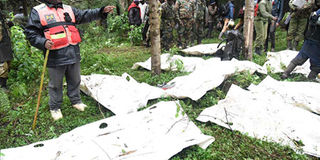Probe to focus on condition of ill-fated plane, crew competence

Rescue teams prepare bodies of FlySax plane crash victims for transportation from the Aberdares on June 7, 2018. PHOTO | EVANS HABIL | NATION MEDIA GROUP
What you need to know:
- Aviation experts have advanced faulty communication equipment and pilot error as potential causes of the clash.
- An aircraft engineer with the sector said safety can be further enhanced through regular inspections.
Investigators into the Tuesday plane crash that killed 10 people are likely to zero in on the aircraft’s condition and the crew’s competence in a bid to establish the last moments of the flight.
An assessment from the crash scene in the Aberdare Ranges indicates that the plane veered off its designated flight path and was flying on low attitude before hitting a peak of volcanic rock.
Its fragments plunged 400 metres down a cliff to Elephant Point and were spread all over, according to rescuers who recovered nine bodies and the black box of the Cessna 208B, registration 5Y-CAC.
WEATHER
As investigators focus on the black box for clues on how the country’s air traffic control system did not alert the pilot Barbara Kamau of the deviation, grieving relatives identified the remains of their loved ones and Safari Air Express (Flysax) staff called for an investigation into the accident.
Among the areas that investigators may look into are the weather at the time of the crash, last communication between its pilot and the control tower at Jomo Kenyatta International Airport (JKIA), the pilots’ flying experience and the aircraft’s airworthiness.
Investigators will also look into whether the control tower gave any instructions to the pilot before it crashed, and if the pilot had requested for any assistance and the action taken on the request.
COMMUNICATION
Aviation experts have advanced faulty communication equipment and pilot error as potential causes of the clash other than bad weather.
A former senior director at the Kenya Civil Aviation Authority said the area the plane crashed was very dangerous for flights because of bad weather and terrain.
The director said pilots should approach such areas with instruments which guide on manoeuvres instead of visibility where the crew can see the ground.
"If there is poor visibility, it is easy to crash. You should not fly without the instruments if you cannot see the ground,” he said.
But could the pilot have been flying without the instruments?
POOR SERVICING
Indeed, this is one of the mysteries employees of the operator want resolved through an enquiry.
They said the plane had equipment to warn the crew when it was flying low or onto an obstacle, a resource they believe Ms Kamau would not have ignored.
Their suspicion is that it could have been faulty after years of poor servicing, if any.
Concerns on servicing have come to the fore because the plane was manufactured in 1996 making it, at 22 years, relatively new.
A list of aircraft operating in Kenya seen by the Nation shows the oldest aircraft was made in 1944.
The list dated 2013 also shows the aircraft had a certificate of airworthiness for up to December 2014.
This makes it difficult to determine its suitability in the past four years although Kenya Civil Aviation Authority has assured the plane was in good condition.
REGULAR INSPECTIONS
Also of concern is the hectic schedule the plane had on the fateful day.
According to sources, the plane left Wilson Airport on Tuesday morning for Maasai Mara before proceeding to Homa Bay and later Kitale airstrip in Trans-Nzoia County.
It left Kitale airstrip at 4.05pm for JKIA, Nairobi, but lost contact with the control tower an hour later when it was due to land in Nairobi.
An aircraft engineer who did not wish to be named because of commercial relations with the sector said safety can be further enhanced through regular inspections.
“An aircraft’s functionality depends on its servicing. It can even be 30 years old but everything inside is new. As a regulator, KCAA inspections can ensure that components are safe,” she said.
Two pilots involved in the search and rescue mission believe the accident might have been caused by the plane’s less horsepower, poor visibility and the crew’s unfamiliarity with the terrain.
There is also the possibility the pilot might have received instructions to deviate from the control tower when they were already in the fogs. Aviation authorities have denied this.






